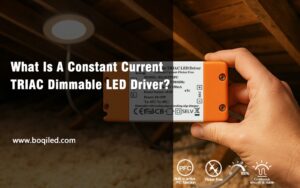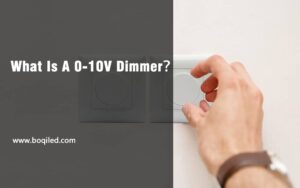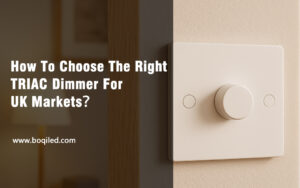Wiring a 0-10V dimmable LED driver can seem intimidating, but with the right guidance, it’s a straightforward process. This guide is for DIY enthusiasts, professional electricians, and general homeowners. It will walk you through each step to make sure the installation is safe and effective.

To wire a 0-10V dimmable LED driver, connect the driver to the power controller using line-voltage conductors (black and white wires) and to the 0-10V controller using low-voltage wires (violet and pink wires). Ensure the low-voltage wiring complies with Class 1 or Class 2 standards.
Let’s dive deeper into the details to ensure a successful wiring process.
0-10V Wiring: It’s Not as Difficult as You Think!
0-10V wiring is an analog technology based on the voltage difference between two wires. This voltage difference results in varying light levels. It is a simple but effective method for dimming LED lights. The basic components include a dimmer, a power supply, an LED driver, and an LED fixture. Understanding how these components interact is crucial for a successful installation. The dimmer sends a low-voltage signal to the LED driver, which adjusts the brightness of the connected LED fixtures. Many people like this method because it is simple and reliable. It gives precise control over lighting levels. Also, the 0-10V system works with many types of LED fixtures. This makes it a flexible choice for homes and businesses. When properly installed, a 0-10V dimming system can offer seamless, flicker-free dimming across a wide range of light levels.
Class I vs Class II Wiring
Class I and Class II wiring classifications are essential to understand for safety and compliance with electrical codes.
– Class I Wiring: This involves running the line-voltage wires, with a voltage of up to 600 volts. It requires more stringent insulation and protection to prevent electrical hazards. Class I systems are typically used in commercial settings where higher power levels are common. The insulation must be strong. It must prevent any short circuits. These could arise from the wires being high voltage. Additionally, conduit systems must be used to provide physical protection to the wiring. This wiring is usually more complex. It may need professional installation. This is to ensure compliance with local electrical codes and safety standards.
– Class II Wiring: This involves running low-voltage wires separately from the line-voltage wires. It is generally safer and easier to manage, especially for DIY projects. Class II systems are often used in residential settings where the power levels are lower. Separating low and high-voltage wires cuts the risk of electrical interference. It also reduces potential hazards. This method allows for simpler installation. It often uses standard low-voltage cables that need little insulation. This separation makes Class II wiring easier for homeowners. It’s for those looking to install their own lighting systems. It simplifies the process and improves safety.
| Type | Class I- Line Voltage Wiring | Class II- Low Voltage Wiring |
| Voltage | Typically 120V or 277V AC | Typically 10–24V DC |
| Feature -1 | Provides both power to lighting fixtures and also a means of grouping them by circuit/switch-leg within “control zones” | Provides a pathway for communication of analog or digital signals, such as incoming sensor input data—e.g., light levels, occupancy conditions—and outgoing commands. |
| Feature -2 | It is not very flexible, imposing limited control options and rigid zoning based on lighting circuiting | Is inherently flexible as most codes do not require it to be installed in conduit. |
The Common Types of Cables Used in Low-Voltage Wiring
When wiring a 0-10V system, it’s crucial to use the right type of cables. The most common cables used include:
– THHN/THWN Wire: Suitable for conduit applications. These wires are thermoplastic high-heat resistant and water-resistant nylon-coated. They are designed for indoor use in dry and damp locations and are known for their durability and flexibility. This makes them ideal for running through conduit systems where sharp bends and tight spaces are common.
– Low-Voltage Communication Cable: Often used for Class II applications. These cables are for low-voltage signals. They are usually shielded to block EMI. They are common in homes and small businesses. They are used to connect dimmers, sensors, and other control devices to LED drivers and fixtures. The shielding in these cables ensures that the low-voltage signals are sent accurately. They are sent without degradation.
– Shielded Twisted Pair (STP): Helps reduce interference in sensitive environments. STP cables consist of pairs of wires twisted together. They are shielded to protect against EMI and RFI. This cable type is great in places with lots of electronic noise. These include industrial settings or areas with many devices. The shielding and twisting of the wires help maintain the integrity of the low-voltage signals over longer distances.
Class I Wiring Methods Recommended in NEC Requirement 725.48
Class 1 circuits can coexist with other circuits as outlined in Sections 725.48 (A) and (B):
(A) Class 1 circuits are permitted to share the same cable, cable tray, enclosure, or raceway, whether they utilize alternating or direct current, provided that all conductors are insulated to the highest voltage present among any conductors within the cable, cable tray, enclosure, or raceway.
(B) Class 1 circuits can also be configured using power supply wires under specific conditions:
(1) Both Class 1 and power supply circuits may occupy the same cable, enclosure, or raceway, but only if they serve a related function.

The 0-10V driver and ballast are categorized as “Class 2” primarily because the ballast acts as a power receiver, not a source. When connected to a Class 2 limited power circuit, it is essential to label the circuit as “Class 2 Circuit,” signaling that the ballast is designed for use with a Class 2 circuit.
Having explored the intricacies of Class 1 wiring, let’s delve into the crucial considerations for Class 2 wiring!
Class 2 Wiring Methods
Class 2 circuit conductors within enclosures, compartments, outlet boxes, device boxes, or similar settings are allowed to be installed alongside electric light, power, Class 1, and other circuits. This setup is permissible solely to facilitate connections to equipment linked to Class 2 circuits under two specific conditions:
(1) Class 1 circuit conductors must be positioned to maintain a minimum separation of 6 mm (0.25 inches) from Class 2 conductors and cables.
(2) The circuit conductors must operate at 150 volts or less to ground and adhere to one of the following stipulations:
The Class 2 circuits should employ Type CL3, CL3R, or CL3P cables, or a suitable alternative, ensuring that any conductors extending beyond the cable jacket are separated by at least 6 mm (0.25 inches) or are enclosed within a nonconductive sleeve or barrier from all other conductors. Alternatively, Class 2 circuit conductors can be installed following the guidelines for a Class 1 circuit. Additionally, 0-10V ballasts and drivers must maintain a spacing of at least 0.25 inches between line voltage and the bus terminals for Class 2 installations.

Things to Remember!
When working with 0-10V wiring, keep these key points in mind:
– Always turn off the power before starting any wiring work. This is a fundamental safety precaution that prevents accidental electrical shocks or short circuits. Verify that the power is off using a voltage tester before handling any wires.
– Follow manufacturer instructions and local electrical codes. The instructions provide specific guidelines. They are for installing and using the manufacturer’s products safely and effectively. Local electrical codes ensure that your installation meets minimum safety standards. They also ensure it complies with local regulations.
– Double-check all connections to ensure they are secure and correct. Loose or incorrect connections can lead to poor performance, flickering lights, or even damage to the LED driver or fixtures. Use appropriate connectors and tools to secure each connection properly.
– Use the correct wire gauge for your installation. Using the wrong wire gauge can result in voltage drops, reduced performance, and potential safety hazards. Refer to the manufacturer’s specs and local codes. Use them to find the right wire gauge for your system.
– Test the system thoroughly after installation. Before finalizing the installation, test the system. Make sure all parts work and that the dimming works as expected. This helps identify any issues early and allows you to make necessary adjustments before completing the project.
By keeping these points in mind, you can ensure a successful and safe installation of your 0-10V LED driver and lighting system.
Is the Connection of the Wires Important in 0-10V Wiring?
Yes, the connection of the wires is crucial in 0-10V wiring. Incorrect connections can result in poor dimming performance or even damage to the LED driver or fixtures. Ensure that all connections are secure and follow the correct polarity. This means that the positive and negative wires must be connected to the corresponding terminals on the dimmer, driver, and fixtures.
It’s important to use high-quality tools and connectors. They ensure the polarity is right. This prevents loose connections. They can cause intermittent issues or complete failure of the dimming system. Use wire nuts, terminal blocks, or crimp connectors as recommended by the manufacturer.
You must also inspect the connections often. This is especially important in places where the wiring may be exposed to vibrations. These places have temperature changes and other factors. These factors could harm the connections. Regular maintenance and inspection can help find and fix issues. It is before they become bigger problems.
0-10V Wire Colors to Change
Previously, 0-10V dimming used a gray and violet pair of wires. This color coding is changing to a new standard, using a pink wire in lieu of the gray wire. Be aware of this change to ensure compatibility with new installations. The new color coding standard aims to cut confusion and boost safety. It does this by using a consistent color scheme for low-voltage dimming wires.
When working on new installations or retrofitting existing systems, verify the wire colors. Make sure they match the new standards. This may involve replacing old wires with the new color-coded ones. Or, using labels to show the correct function of each wire.

Following the new color coding standard helps. It makes sure your installation is up-to-date and follows current industry practices. This can also make future maintenance and troubleshooting easier. The colors help to identify and work with the wires.
What is the Recommended 0-10V Gauge Wire?
The recommended wire gauge for 0-10V dimming circuits is typically 18 AWG. This gauge provides a good balance between flexibility and durability for most installations. Using the right wire gauge is essential. It ensures that the dimming signals are sent accurately. They are sent without much voltage drop.
For longer runs or installations with multiple fixtures, it may be necessary to use a thicker gauge wire to maintain the integrity of the signal. Thicker wires have lower resistance, which helps prevent voltage drops over longer distances. Check the manufacturer’s specs and local codes. Use them to find the right wire gauge for your installation.
Using the correct wire gauge not only ensures reliable performance but also enhances the safety of the installation. Thin wires can overheat, causing fire hazards. Thick wires are harder to work with and needlessly raise installation costs.
How Far Can I Run a Low-Voltage 0-10 V Circuit?
The maximum distance for running a low-voltage 0-10V circuit depends on the total load and wire gauge. Generally, with 18 AWG wire, you can run the circuit up to 200 feet without significant voltage drop. For longer distances, consider using a thicker gauge wire to maintain performance.
Voltage drop occurs when the resistance of the wire causes a reduction in voltage as the current travels along the wire. This can affect the performance of the dimming system, leading to inconsistent or reduced light levels. To minimize voltage drop, use the appropriate wire gauge for the distance and load of your installation.
When planning your wiring layout, consider the placement of the dimmer, driver, and fixtures. This will help you make the wire runs shorter and minimize the distance. This can help reduce the need for thicker wires and simplify the installation process.
Additionally, ensure that all connections are secure and that the wires are properly protected and organized to prevent damage and maintain the integrity of the circuit over time.
Points to Remember
- 호환성 확인: Ensure all components are compatible with 0-10V dimming.
- Follow NEC Guidelines: Adhere to all NEC requirements for wiring.
- Test Before Finalizing: Test the system thoroughly before finalizing the installation.
By following these points, you can ensure a successful and safe installation of your 0-10V LED driver and lighting system.
닫기
If you need any 0-10V 조광 가능 LED 드라이버 그리고 0-10V 디머, please click the sort to know more.








